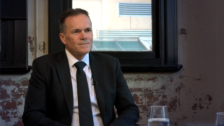How to select a fund manager
The selection of money managers necessitates myriad considerations. That there’s a science element goes without saying – especially now, with artificial intelligence going some way to democratising quantitative analysis – but the act of fund manager selection includes a host of other, less prosaic variables that often get forgotten.
Understanding the more qualitative side of funds management, or the ‘art’, is how investors can better equip themselves to identify what good and bad looks like.
“A lot of what we do in the industry is really focused on the quantitative aspects, which is easy to understand, easy to track and easy to assess,” explained Benjamin Lam, Colonial First State’s head of equities, at The Inside Network’s recent Equities and Growth Symposium in Sydney. “But there is a lot of art that’s part of the assessment of managers.”
The first thing to remember is that the investor carries a lot of the responsibility in the assessment, Lam (pictured) said. Due diligence is not just something that’s done upfront, but an ongoing process that needs to remain front of mind and worked in tandem with the science. When an investor is trying to understand their own risk tolerance, for example, they need to keep a constant tab on what level of manager underperformance (and over what period) they’re comfortable with.
“What I want to see with managers is, ‘hey, yes, there can be headwinds to performance, but I am comfortable with my approach in investing. I can always improve.” – Benjamin Lam
“Inevitably, with growth managers, there will be periods of underperformance, so it’s really important to assess what your true time horizon is. Are you worried about any single year and the performance profile of the manager and strategy within that context, or do you have a truly long-term time horizon? With all these matters there’s a bit of subjectivity.”
Subjectivity is a key element, Lam reiterated, because everyone is going to look at managers in different ways and prioritise different things.
“You’re looking at things like personalities, philosophy and culture, but we could survey the room and people would have different ways of assessing and thinking through what is important in differentiating strategy and approaches,” he said.
Yet assessing the art elements isn’t always easy, because fund managers are product providers with a core sales element to their practice. As most financial advisers would know, some fund managers obfuscate the truth, and an impossible number of them report top quartile performance. Lam used ESG as an example of an issue that’s difficult to gauge without really digging deep.
“We can’t avoid the alignment of values and what we think about ESG. Most managers, in their slide decks and pitch books, will have some detail around their ESG processes, what they do and how they think. But how do you actually assess what are they really doing underneath the hood? And are they truly living and breathing ESG?”
Investors, then, should strive to feel comfortable with the level of honesty and transparency they get from a manager. And if they feel like a manager is lying or making excuses – about a poor performance period, for example – this can set the relationship back immeasurably.
“Often when they’re underperforming they say ‘there’s something outside my control’, or ‘it’s The Magnificent Seven’… the GRANOLAS in Europe,” he said. “What I want to see with managers is, ‘hey, yes, there can be headwinds to performance, but I am comfortable with my approach in investing. I can always improve. Were there any things I could have picked up that would have led my process to actually own some of those stocks that would have had wins? If not, that is perfectly fine.
“What I also want to see in strongly performing managers is continuous improvement despite strong and positive performance,” Lam continued. “They’re always looking to do things better. Could I have bought earlier? Should I have sold earlier in certain instances and thought more about position sizing?”
Transparency and engagement
Also on stage, Spire Capital investment manager Scott Dingle noted that this need for transparency extends to elements like fund valuations – especially in private markets.
“People often describe valuations in private market as being very opaque, and we tend to agree with that,” Dingle said. “But these are highly illiquid, idiosyncratic assets, and the managers are marking them themselves. Yes, there’s auditors involved… but at the end of the day, the managers are marking their own homework.”
Regular engagement is also strong indicator of trust between a provider and investor. Lam reckons a dip in this engagement can often mean something is amiss at a manager.
“Portfolio Managers are people, they will have their ups and downs and ebbs and flows in energy levels, but it can be a cause for concern when some of those energy, high energy PMs, you’ve engaged seem a bit distracted. Try to dig a bit deeper and understand what is distracting that manager.” he said. “PMs are often very senior people in organizations, they’re inside the tent with any corporate changes and restructures, so that might be weighing on that on them a bit.”
It may be an ubiquitous catch-all term, but assessing the culture of a fund management team is a key element of the art, he continued. “When there is a positive culture, there is a positive team dynamic and people are bringing their full selves into work on a daily basis. They’re fully engaged, they want to improve their processes, they’re actively conversing with the portfolio manager, they want to bring their best ideas, their ideas are actually being listened to.
“You want to understand not only how the portfolio manager thinks, but how other team members contribute into an investment process. If I’m directing questions directly at the analyst, but the fund manager constantly interrupts and answers, that to me highlights a lack of trust in his team, and not a positive culture for an analyst to actually thrive and contribute as well.”











